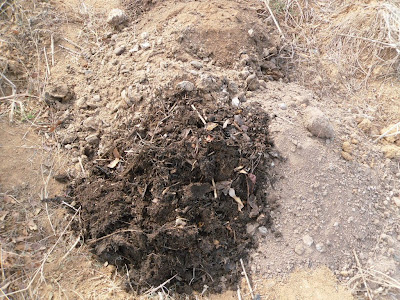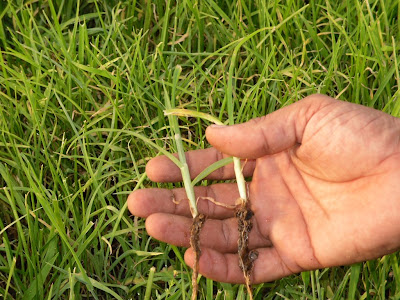and also the toughest blogpost.
this was item 3 on our things are afoot post over a month ago.
april 2nd week
we decided to sow ragi in month of april mid to may mid (called chittirai pattam - aka chittirai month sowing season).
we selected a patch of land approx 2500 sq ft (hereinafter called 'field').
I. preparation of field - since the field was lying fallow, we needed to add nutrition. we did this by using the amrut mitti system - albeit, modified. we spread to approx 2 inches height of leaves/grass soaked in amrut paani over around 2000 sq ft. due to limitations of availability of biomass and time constraints. this is how the soaking is done. this process took around 7 days of 2 hours each of physical work.


then the field was mulched with wild grass (dried).
normally any field is ploughed with the added biomass/dung etc., prior to the crop.
in our case, the constraint of water availability determined the approach to be a no-till crop.
mulching also serves to retain moisture, contain weed growth and increase micro-organism activity.

II. preparation of the nursery patch (april 20th) - we decided (with inputs from many neighbouring farmers) to use the transplant method instead of the open broadcast method. this is the classically used system for most grains. this enables people to choose the best sapling and plant the field in a orderly manner.
we apportioned around 200 sq ft of nursery patch in a corner of the field.

this patch was levelled, deweeded, watered and we mixed a variety of manure (dried cowdung - dull brown colour, farmyard manure - steel gray colour and decomposed vegetable matter-dark colour) and spread it around this patch.



then the seeds were sown.
these seeds were from karnataka and were sourced through a friend and originated at green foundation.



check out the simple hand-raking system to even out the seeds.

a look at the hardworking csm team.

this process was easy and fun and lasted all of 1 hour for 4 people.
and the saplings grew beautifully.


april 4th week
III. intercropping with karamani - cow pea
to attempt a simple mixed cropping system, we planted karamani (chouli beans) in rows approx 27 inches apart. the ragi would be transplanted in 2 rows in between this gap in the karamani rows.
the advantages of intercropping are obvious and the use of a legume and grain in combination is supposed to help each other.
also we love karamani. it is hardy and bountiful. and look how quickly it has sprouted and taken its place (this is within 10 days of planting karamani which was planted 10 days after the ragi as planted in the nursery bed ).

may 2nd week
4. transplanting (may 12th to 14th) - we waited for the saplings to grow to a decent size (as seen in image) and in our case it took approx 22 days to grow to that size.

the nursery patch was watered and the saplings plucked out and handed out to 3 teams of 2 each.
we remain indebted to 2 volunteers who were around to help us in this arduous process - siddharth and arvind.
one would make holes in the space between the karamani rows (with a pointed wooded stick) and the other would plonk 2 saplings and close the hole.
much tougher than we imagined.
it took around 25 personhours to complete this task over 3 sessions.
it is recommended that the planting is done in the evening to allow the saplings to live their first 10 hours in the relative cool of the night.



here is the planting team (csm, siddharth, annamalai, raju and chellama in the front).

the field as on today - day 40.

general comments and observations.
1. transplanting method is physically very intensive.
2. managing weeds. especially in the areas where the mulch levels were low or were moved to sow the karamani/transplant the ragi. as on date, we have spots which are heavily weeded and will take hours of effort to remove.
3. watering - we are using a sprinkler system to water the field. the other option was to use a watering hose. this system is simple, gentle and time consuming and is blind to certain spots in the field (circular watering in a rectangular field). and in spots which have heavy mulch, the water hardly seeps through to the ground.


4. soil type - in heavy clayey soil (which we have in some places), the transplanting is like hammering a nail with your fist.
5. we were helped by the 2 bouts of rain - one during karamani planting and one during the laila storm.
we have some improvements lined up in our next ragi crop. in early 2011.
2 comments:
Great show! I don't know if Nari Payaru (Fox Bean, Fox Pulse) grows there (sown in June here) but it drowns weeds by hanging very close to the ground and spreading fast. May be worth experimenting on a small scale.
thanks nisha - will check it.
read about it in pasumai vikatan, but could not get info from the net. need to check with the locals.
we see that sweet potato is very much a full fledged low level cover on the veg beds.
how does one sow a grain crop over the nari payaru? or is is like sun hemp types green manure?
Post a Comment